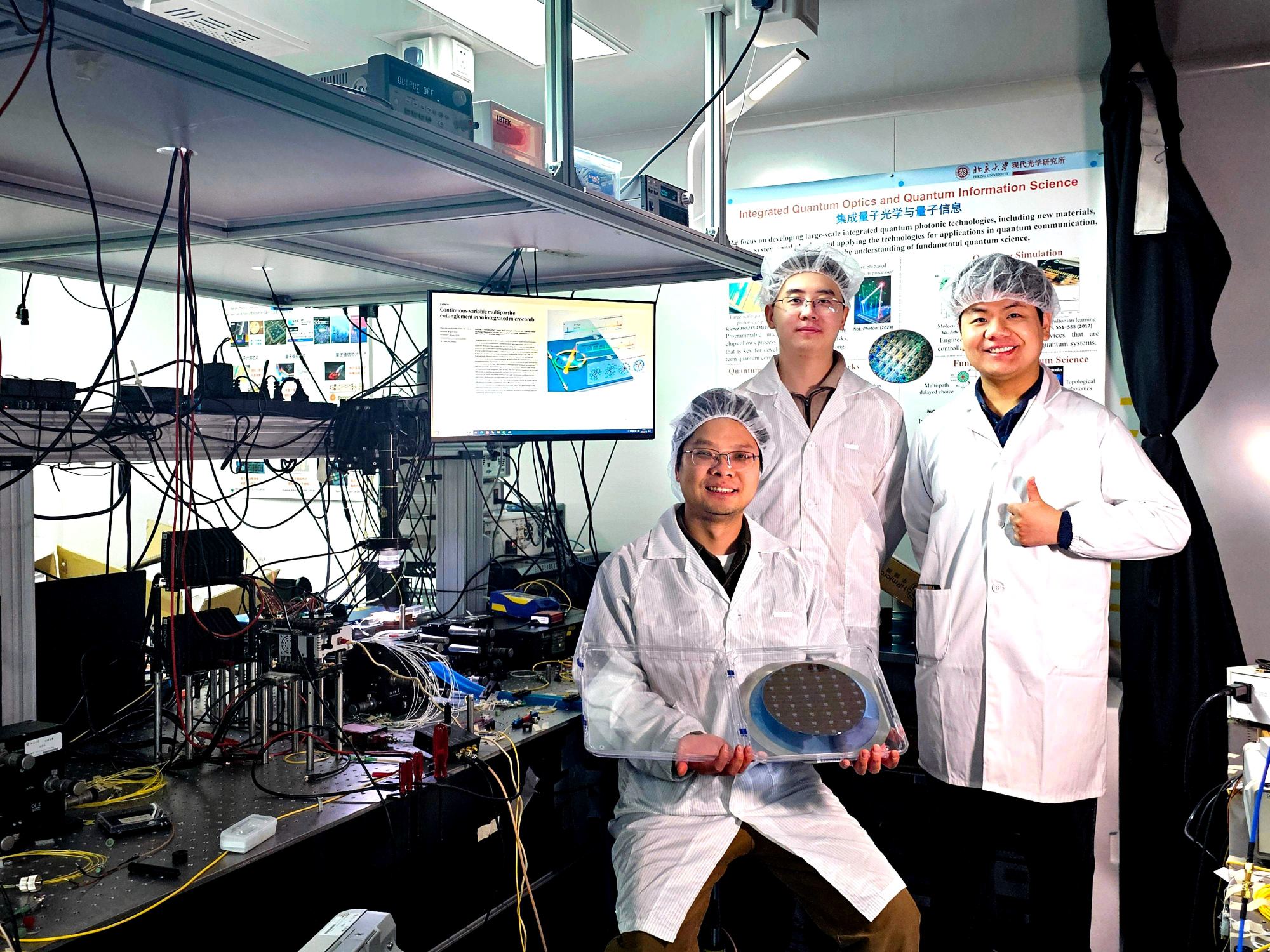As the United States continues to tighten restrictions on chip exports to China in a bid to curb the country’s access to advanced semiconductors, Chinese researchers have gone into overdrive.
In recent years, Chinese universities have been leading the world in research on chip design and fabrication. And they are producing much of the basic research that could influence next-generation semiconductor technology – and position China ahead of the pack.
From 2018 to 2023, nine of the top 10 biggest producers of English-language research on chips were Chinese institutions, according to a report released in March by the Emerging Technology Observatory at Georgetown University in Washington.
Do you have questions about the biggest topics and trends from around the world? Get the answers with SCMP Knowledge, our new platform of curated content with explainers, FAQs, analyses and infographics brought to you by our award-winning team.
Eight Chinese universities appear in the top 10 list of the most highly cited articles – or the top 10 per cent with the most citations each year in that period.
Only two institutions from other countries made the two lists: the Centre National de la Recherche Scientifique in France ranks third for total articles published, and 10th for the most citations; and the National University of Singapore ranks ninth for top-cited research.

No institutions from the United States – the second largest producer of research on chip design and fabrication – made the top 10 lists for total articles published or most-cited articles.
Chip research is an area of intense rivalry between China and the US as both countries try to take the lead in next-generation semiconductor technology.
US-led sanctions that restrict China from obtaining high-end chipmaking tools have stymied the country’s production of advanced semiconductors. But the US might not be able to retain its competitive advantage through the use of export controls, the authors of the ETO report told Nature.
ETO lead analyst Zachary Arnold told the journal the research mainly captured emerging chip technology rather than commercial advances, and the analysis on global chip research did not take into account internal industry research or patents.
In growth areas of chip research – such as computing architecture inspired by neurons or optical computing that uses light rather than electrons to carry information – China was leading the way in terms of number of papers published, according to Arnold.
So which Chinese institutions are publishing the most research, and who are the scientists behind the country’s drive to build advanced chips?
Chinese Academy of Sciences
Based in Beijing, the academy is the largest research organisation in the world, with institutes across China.
It topped the ETO list of big hitters on chip design and fabrication research, both for total articles published and top-cited articles published from 2018 to 2023.
The CAS published more than 14,300 chip-related papers in that period, with over 3,400 on the list of highly cited articles.
One of the hottest areas in the field is neuromorphic computing, which aims to mimic the human brain and could revolutionise chip design by creating more adaptable and efficient processing.
The CAS topped the ETO ranking for published research in the area that includes neuromorphic computing.
In another area, a Chinese team reported that they had developed the world’s first carbon-based microchip that can run artificial intelligence tasks. Their paper in the journal Science Advances in January said the carbon nanotube transistor chips could process data not just in ones and zeros like most modern electronic devices, but also in a third value. This ternary logic system could enable faster computation using less energy.
Materials scientist and CAS member Peng Lianmao – who has been exploring carbon-based chip technology for more than two decades – was a lead researcher on the study.

University of Chinese Academy of Sciences
UCAS – a public university in Beijing affiliated with the CAS – ranked second on the ETO list for the total number of articles published on chip design and fabrication, with nearly 7,850. It was also second for top-cited articles with around 1,750 papers.
The university was also on the ETO’s top 10 list for the research area that includes neuromorphic computing and devices.
A 2018 paper in the peer-reviewed journal Chemical Society Reviews about a structural analysis technique applied to graphene materials – by a team that included researchers from the CAS and UCAS – ranked fourth on the ETO’s list of top-cited chip articles.
Tan Pingheng from the UCAS College of Materials Science and Opto-Electronic Technology was lead researcher on the paper. Tan, whose area is semiconductor physics, has been named a highly cited scientist by analytics platform Clarivate and academic publisher Elsevier, according to his research team’s website.
Tsinghua University
Based in Beijing and one of China’s top two universities, Tsinghua also ranks among the global top 20.
It placed fifth on the ETO list for published research on chips, with nearly 4,650 papers, and third on the top-cited articles list with nearly 1,280 papers.
Sun Nan, an expert on semiconductors, has helped create more than 50 cutting-edge chips since he joined Tsinghua University in 2020 after spending more than a decade in the US at the University of Texas at Austin.
Those chips have been used in areas like high-speed trains, electric vehicles, and the power grid.
He has also been working on manufacturing issues so that chips that were previously imported can be made in China, according to Tsinghua.
In 2023, a team from Tsinghua led by Wu Huaqiang and Gao Bin unveiled the world’s first fully system-integrated memristor chip – a type of resistor, or circuit element, that limits the flow of energy and can remember the most recent value of current passed through it.
This kind of chip is capable of improvement-based learning, which could help reduce the energy required for training artificial neural networks by allowing learning to occur on-chip with no external memory source.
Tsinghua ranked fourth on the ETO top 10 list for research that includes deep learning and neural network-based research.
University of Electronic Science and Technology of China
UESTC – located in Chengdu, Sichuan province in the southwest – is sponsored by the Ministry of Industry and Information Technology.
It ranked fourth on the ETO list for total articles, with nearly 5,240 papers published.
Last year a UESTC team led by Ning Ning, head of a laboratory set up by the university and telecoms giant Huawei Technologies, said they had developed a device that could reduce the time delay of electronic warfare receivers, which could make radar signal detection much faster.
UESTC researchers also made progress on building a quantum chip, with the first use of a common semiconductor to create a quantum light source.
Quantum computing chips – which use quantum bits rather than the classical bits used in classical computing chips – could help solve complex problems faster than conventional computation.
Nanjing University
One of China’s oldest universities, Nanjing is located in the capital of eastern Jiangsu province, and ranked sixth on the ETO’s list for chip research, with nearly 4,250 papers published in the period. It was fourth on the top-cited articles list with 930 papers.
The most cited paper on chip design and fabrication published from 2018 to 2023 – with 2,043 citations – was written by a team that included researchers from Nanjing and published in the peer-reviewed journal Nature in 2018, according to the ETO.
The paper on ferromagnetism – a physical phenomenon in which certain materials like iron strongly attract each other – has implications for developing spintronic devices. The devices leverage the spin of electrons rather than electrical charge to store data and can be used as a more efficient alternative to traditional chips.
Nanjing University was also on the ETO’s top 10 list for published research in the area of quantum computing and quantum processors.
Huazhong University of Science and Technology
Located in Wuhan, in the central province of Hubei, HUST ranked eighth on the list for articles published, with just over 3,660 papers in the period. It was fifth for top-cited articles with around 890 papers.
One of its newest recruits is Wang Huanyu, who was an implementation engineer for central processing units at the US headquarters of Apple from 2021 until December. He took up a job as a professor with HUST, his alma mater, in the integrated circuits school that was established in 2023.
Wang helped develop some of the latest system-on-a-chip processors used in Apple’s Mac computers and iPads.
Other Chinese universities, including Tsinghua and Peking, have also set up integrated circuit schools to train the next generation of tech talent.
Zhejiang University
Zhejiang, located in the provincial capital Hangzhou in China’s east, takes ninth spot on the ETO’s list for published research, with around 3,580 papers, and sixth for top-cited articles, with nearly 870 papers.
The university also ranks highly in two research areas that involve photonics – a branch of optics that harnesses the power of light through photons for various applications.
Photonic chips use light or photons rather than electrons to process and transmit information, which travels faster and could therefore lead to higher data transmission speeds.
According to the ETO, photonics are increasingly used for high-speed networking and data communication between processors.

Peking University
One of the top 20 universities in the world, and one of the top two in China, Peking came 10th on the ETO list for total articles, with around 3,440 papers published. The university in Beijing was eighth for top-cited articles, with 810.
In February, a Peking University team led by Peng Hailin claimed to have shattered chip performance limits with a self-engineered 2D transistor that outperformed the most advanced comparable devices from Intel, TSMC and Samsung when placed under the same operating conditions.
They said their device could be made using existing processing technologies, and without silicon. That is important for China since it cannot currently make the most advanced silicon-based transistors because of US-led sanctions.
Also in February, an international team led by Peking researchers unveiled a 100-gigahertz all-optical chip that harnesses light rather than electricity to synchronise processors, which could unlock high-speed AI computing and next-generation remote sensing.
The lead author of that paper, Chang Lin, is an assistant professor at Peking’s electronics school and has been recognised for his pioneering work in integrated photonics, according to the university. He won an IEEE Photonics Society Young Investigator Award in 2023 that recognises outstanding contributions to the field by scientists aged under 35, and has published over 30 papers in prestigious international journals.
More from South China Morning Post:
- China’s chip exports keep rising as US ‘national security’ review looms in trade war
- Chip war: China amends ‘place of origin’ in boost to local semiconductor manufacturers
- China’s chip trade faces uncertainty after growing in first quarter amid US tariff war
For the latest news from the South China Morning Post download our mobile app. Copyright 2025.





